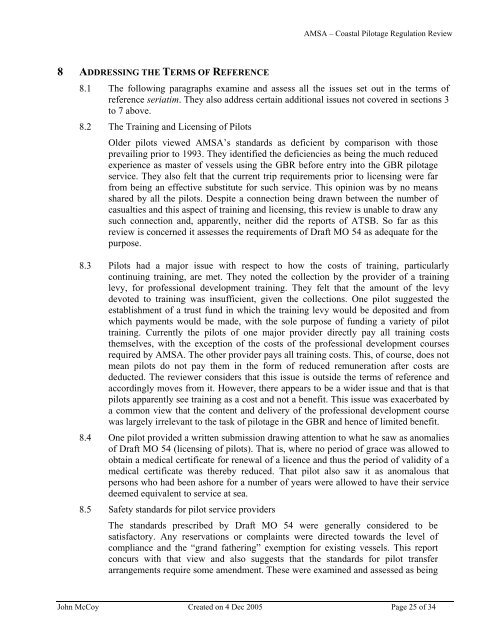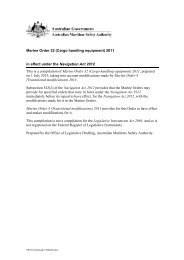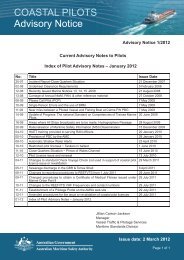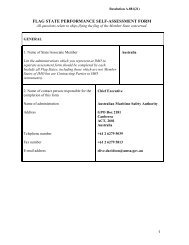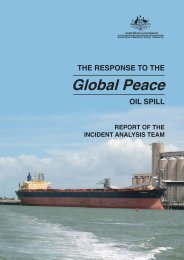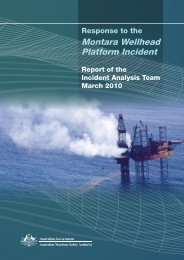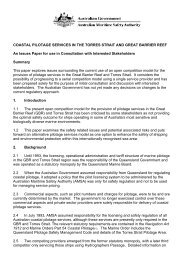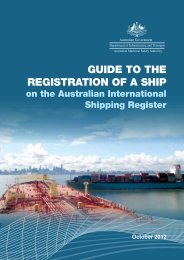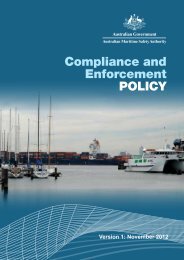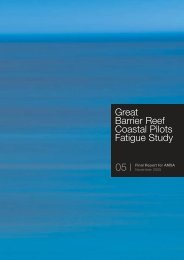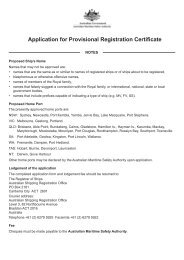Coastal pilotage regulation review - Australian Maritime Safety ...
Coastal pilotage regulation review - Australian Maritime Safety ...
Coastal pilotage regulation review - Australian Maritime Safety ...
Create successful ePaper yourself
Turn your PDF publications into a flip-book with our unique Google optimized e-Paper software.
AMSA – <strong>Coastal</strong> Pilotage Regulation Review8 ADDRESSING THE TERMS OF REFERENCE8.1 The following paragraphs examine and assess all the issues set out in the terms ofreference seriatim. They also address certain additional issues not covered in sections 3to 7 above.8.2 The Training and Licensing of PilotsOlder pilots viewed AMSA’s standards as deficient by comparison with thoseprevailing prior to 1993. They identified the deficiencies as being the much reducedexperience as master of vessels using the GBR before entry into the GBR <strong>pilotage</strong>service. They also felt that the current trip requirements prior to licensing were farfrom being an effective substitute for such service. This opinion was by no meansshared by all the pilots. Despite a connection being drawn between the number ofcasualties and this aspect of training and licensing, this <strong>review</strong> is unable to draw anysuch connection and, apparently, neither did the reports of ATSB. So far as this<strong>review</strong> is concerned it assesses the requirements of Draft MO 54 as adequate for thepurpose.8.3 Pilots had a major issue with respect to how the costs of training, particularlycontinuing training, are met. They noted the collection by the provider of a traininglevy, for professional development training. They felt that the amount of the levydevoted to training was insufficient, given the collections. One pilot suggested theestablishment of a trust fund in which the training levy would be deposited and fromwhich payments would be made, with the sole purpose of funding a variety of pilottraining. Currently the pilots of one major provider directly pay all training coststhemselves, with the exception of the costs of the professional development coursesrequired by AMSA. The other provider pays all training costs. This, of course, does notmean pilots do not pay them in the form of reduced remuneration after costs arededucted. The <strong>review</strong>er considers that this issue is outside the terms of reference andaccordingly moves from it. However, there appears to be a wider issue and that is thatpilots apparently see training as a cost and not a benefit. This issue was exacerbated bya common view that the content and delivery of the professional development coursewas largely irrelevant to the task of <strong>pilotage</strong> in the GBR and hence of limited benefit.8.4 One pilot provided a written submission drawing attention to what he saw as anomaliesof Draft MO 54 (licensing of pilots). That is, where no period of grace was allowed toobtain a medical certificate for renewal of a licence and thus the period of validity of amedical certificate was thereby reduced. That pilot also saw it as anomalous thatpersons who had been ashore for a number of years were allowed to have their servicedeemed equivalent to service at sea.8.5 <strong>Safety</strong> standards for pilot service providersThe standards prescribed by Draft MO 54 were generally considered to besatisfactory. Any reservations or complaints were directed towards the level ofcompliance and the “grand fathering” exemption for existing vessels. This reportconcurs with that view and also suggests that the standards for pilot transferarrangements require some amendment. These were examined and assessed as beingJohn McCoy Created on 4 Dec 2005 Page 25 of 34


